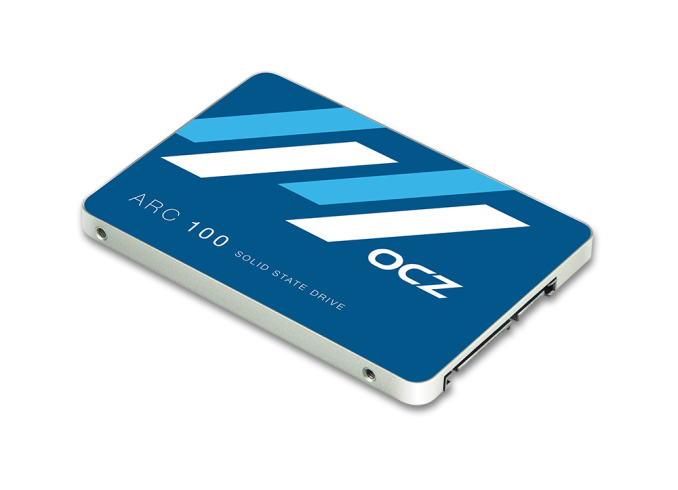OCZ Launches ARC 100 Value SSD
by Kristian Vättö on August 13, 2014 3:05 PM EST
The release of the Vector marked as a change in OCZ's strategy. With a new CEO, OCZ's goal was to change the company's brand image from being a low-cost value brand to a higher-end, high performance and quality SSD manufacturer. For the first time, OCZ decided not to release a value version (Agility-level drive) of its Barefoot 3 platform and only focused on the higher-end market with the Vector and Vertex 4xx lineups. Almost two years later since the introduction of the Vector, OCZ is now finally comfortable with bringing the Barefoot 3 platform to the mainstream market and the ARC 100 acts as the comeback vehicle.
| OCZ ARC 100 Specifications | |||||
| Capacity | 120GB | 240GB | 480GB | ||
| Controller | OCZ Barefoot 3 | ||||
| NAND | Toshiba A19nm MLC | ||||
| Sequential Read | 475MB/s | 480MB/s | 490MB/s | ||
| Sequential Write | 395MB/s | 430MB/s | 450MB/s | ||
| 4KB Random Read | 75K IOPS | 75K IOPS | 75K IOPS | ||
| 4KB Random Write | 80K IOPS | 80K IOPS | 80K IOPS | ||
| Steady-State 4KB Random Write | 12K IOPS | 18K IOPS | 20K IOPS | ||
| Idle Power | 0.6W | 0.6W | 0.6W | ||
| Max Power | 3.45W | 3.45W | 3.45W | ||
| Encryption | AES-256 | ||||
| Endurance | 20GB/day for 3 years | ||||
| Warranty | Three years | ||||
| MSRP | $75 | $120 | $240 | ||
Similar to Vector 150 and Vertex 460, one of the main focuses in the ARC 100 is performance consistency and OCZ remains to be one of the only manufacturers that reports steady-state performance for client drives. The biggest difference to Vector 150 and Vertex 460 is in the NAND department as the ARC 100 utilizes Toshiba's second generation 19nm NAND, i.e. A19nm as Toshiba calls it. Despite the smaller process node NAND OCZ is rating the ARC 100 at the same 20GB of writes per day for three years as the Vertex 460, although the ARC 100 is slightly slower in performance and also drops bundled cloning software and 3.5" adapter.
Given the smaller cell size of the A19nm NAND, OCZ is able to price the ARC 100 more aggressively. At higher capacities OCZ is able to hit the $0.50/GB mark and the ARC 100 is actually very price competitive with Crucial's MX100, which has been our favorite mainstream SSDs for the past couple of months. I am getting back from the US tomorrow and my review samples are already waiting for me at home, so you should expect to see the full review next week!










15 Comments
View All Comments
hojnikb - Wednesday, August 13, 2014 - link
can't*harrynsally - Thursday, August 14, 2014 - link
After following SSD development for 4 years, not only has the cost substantially gone down, their storage capacity has gone up and reliability has dramatically improved.Finally installed my first SSD, a Crucial MX100 256GB, because it had a great price ($.40/GB) and stellar user reviews (90% 5 stars at NewEgg, Amazon etc.).
harrynsally - Thursday, August 14, 2014 - link
I would strongly suggest avoiding the value SSD manufacteurs such as OCZ, Kingston and PNY.The above are well know for bait and switch practice, poor support and/or customer satisfaction (e.g. check the reviews).
http://mobile.extremetech.com/latest/221524-ssd-sh...
So many superior choices that include Samsung, Cruical and Sandisk.
harrynsally - Thursday, August 14, 2014 - link
I strongly suggest avoiding all the value brands, which include OCZ, Kingston, PNY etc.Each of the above has exhibited far to many shady practices, poor customer support and/or satisfaction, when there are so many other superior manufacturers of client SSDs (e.g. Samsung, Crucial, Sandisk) to consider.
For example: http://mobile.extremetech.com/latest/221524-ssd-sh...
farhadd - Friday, August 15, 2014 - link
Shouldn't the higher capacity drives have a higher endurance rating?